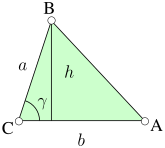@Zarathustra,
Quote:Scientists regularly working in spatial areas on the order of the barn (10−28 m2) are not likely to make such a blunder – to say the least :-)
This sentence makes me laugh. I think you can't leave science to scientists alone any more than war to generals. Look at the genetic modification and the chimpanzees experiment in Africa by Dr. Hilary Poprowski (spelling).

Isosceles triangle

The top angle is 6.5 degrees or .11 radian
The sides are 4000 miles, roughly the earth's radius.
x2 is the base length or stright distance grom CERN to Gasso at ground level.
x2a is the length of the straight path between CERN and Gasso at 1400 meters depth.
I have included an image of a triangle for your benefit.
First assumption was the curved path was 730 km
Second Assumption was the straight path was 730 km.
My calculations of y, depth of crust at the mid-section of x2a.
y = Rcos(Ø/2), miles = 3,993.56
y = Rcos(Ø/2), km = 6,434.61
x2 = R-y, miles = 6.44
x2 = R-y, km= 10.36
x2a =x2+1.4 km @1400m dept = 11.76
y = Rcos(Ø/2), miles = 3,993.57
y = Rcos(Ø/2), km = 6,426.85
x2 = R-y, miles = 6.43
x2 = R-y, km = 10.35
x2a = x2+1.4 km@ 1400 m depth = 11.75
The crucial distance:
Difference (730m-x1a), miles = 0.34
Difference (730m-x1a), feet = 1,803.84
Difference (730m-x1a), km = 0.55
Difference (730m-x1a), m = 549.80
Difference (730m-x1a), miles = 0.10
Difference (730m-x1a), feet = 520.93
Difference (730m-x1a), km = 0.16
Difference (730m-x1a), m = 158.77
The straight path underground at 1400 meter is shorter than 730 km for both assumptions. It is shorter by 549.80 meter assuming a curved 730 km curved path at the surface between CERN and Gasso.
In the second assumption it is shorter by 158.77 meters. The only markers in this project are the plumb lines of the shafts.
I wonder if you understand that digging plumb line elevator shafts point to the center of the earth thus forming a triangle from the center of the earth to the two labs CERN and Gasso.